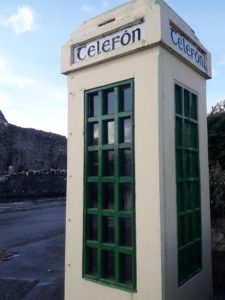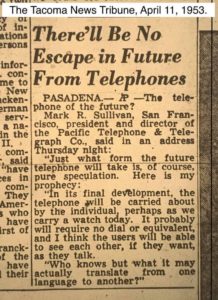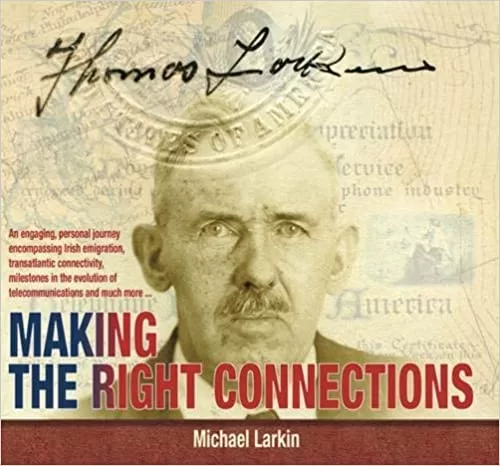“The degree of connectivity between Ireland and its diaspora throughout the world is extremely strong.”
-pg. 91, Making the Right Connections
Michael Larkin traces the path of his great-grand uncle Thomas Larkin through the annals of history, following Thomas as he made the journey to the US that so many of his countrymen and women also undertook at that time. Putting everything on the line for a chance of a better life, Thomas eventually found work with the Bell Telephone Company in Pittsburgh, Pennsylvania. The telephone was not long after its infancy as new technology, and emigrants such as Thomas Larkin were called upon to stretch its lines and connect America.
The Emigrant Story
 In examining the narrative of one Irishman in the late 19th and early 20th century, Making the Right Connections expands out to tell the story of many people on the Ireland affected by landlordism on the island. After going across the Irish sea and eventually becoming restless in Lancaster, Thomas Larkin decided to take a chance to see if all the promises of a better life in the young republic of the United States were true.
In examining the narrative of one Irishman in the late 19th and early 20th century, Making the Right Connections expands out to tell the story of many people on the Ireland affected by landlordism on the island. After going across the Irish sea and eventually becoming restless in Lancaster, Thomas Larkin decided to take a chance to see if all the promises of a better life in the young republic of the United States were true.
Author Michael Larkin gives us all the details necessary to imagine what such a journey was like, and what was at stake in taking it. Many of these emigrants would never get to see their homeland again, losing touch with their families and culture. By telling his uncle’s story, Michael is, in essence, giving account to all of these young men and women.
A World in Flux

Thomas Larkin left his hometown of Derrew in County Mayo more than one hundred years ago, in a very different world than the one we live in now. Michael Larkin vividly paints rural Ireland in the 1800s: the depopulation after the Great Famine in 1845-1850, the difficulty of families feeding themselves, and evictions by landlords.
At the same time, with illustrative pictures, Larkin presents to us Pittsburgh during the same era, a young industrial city relying on cheap immigrant labor to produce steel for the rest of the country. Larkin sets us in the middle of the smokestack haze and allows us to wander around back then.
The Story Behind the Telephone
 “Well informed people know that it is impossible to transmit the voice over wires, even if it were possible, it would be of no practical use.”
“Well informed people know that it is impossible to transmit the voice over wires, even if it were possible, it would be of no practical use.”
-The Boston Post, quoted on pg. 29
One of the stories within the wide-ranging latitude of Making the Right Connections is the background to how the telephone was invented by Alexander Graham Bell. Michael Larkin succinctly yet deftly sets the stage for the young eager school teacher working at night on his new contraption with his assistant Thomas Watson, railing against nearly universal skepticism. Following inventing what would become the telephone, it wasn’t until it was demonstrated at the Centennial Exposition World Fair in 1876 that momentum for its widespread use was garnered.
Part of the charm of Making the Right Connections is the ease with which Michael Larkin dips in and out of moments in history, always setting the stage for our imagination as he delivers the larger story.
The Connections that Bring Us Together
One of the skills of Making the Right Connection is weaving together so many moments and places in the last several hundred years, from South Mayo in the 1840s to modern-day Denver. Part of that is actualized when Michael Larkin himself made the same journey as his granduncle, going to Pittsburgh and then other points west in the United States, linking himself with his uncle through time.
Ultimately, Making the Right Connections asks us to consider the technology behind improving communication and bringing people together, and to take that gift seriously. This love letter to the past reminds us of the value in seeking out those who came before us and honoring their contributions.
![]()
Making the Right Connections is published by Book Hub Publishing and is for €17.99.
Copies of the book available from Castle Bookshop, Castlebar and other good bookshops, or online at www.MayoBooks.ie.


